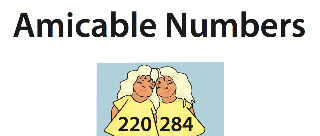Mathematicians say that two positive integers are amicable or friendly if each of them is equal to the sum of all the proper divisors of the other, including 1. Proper or aliquot divisors are all the positive divisors of a number, excluding the number itself. The numbers 220 and 284 are called amicable.
Take a look at the proper divisors of these two numbers:
220 284
Divisors Divisors
1 (220) 1 (284)
2 110 2 142
4 55 4 71
5 40
10 22
11 20
When we add together the proper divisors of 220 (1, 2, 4, 5, 10, … , 110) we get the other number (284). Likewise, the sum of the divisors of 284 (1, 2, 4, 71, 142) is equal to the first number (220). Each amicable number has the power to generate another, thus symbolizing mutual harmony, perfect friendship and love.
The amicable numbers were thought by mystics to possess magical powers. Astrologers used these numbers for preparing talismans and horoscopes. They believed that amicable numbers had the power to create special ties between individuals. They also saw these number pairs as symbols of friendship.
Read more on the MathForum.org.
For over a thousand years, only this first pair (220 and 284) was known. It was attributed to the philosopher Iamblichus (c.250-330), who credited Pythagoras. Eventually, the mystical quality of amicable numbers caused them to be studied more carefully by number theorists.
The next amicable pair (17,296 and 18,416) was probably discovered in the 9th century by Arab mathematician Thabit ibn Qurra. In 1636, Pierre de Fermat rediscovered this pair. Later, René Descartes discovered a third pair: 9,363,584 and 9,437,056.
Then, in 1747, Leonhard Euler published a short paper [E100] mentioning the technique that Descartes and Fermat had used, and listing 30 amicable pairs, including the three already known, and including one “pair” that was not actually amicable.
A total of 59 pairs were found by Euler, among them the pair (6,232 ; 6,368) and the pair (10,744; 10,856). B.N.I. Paganini, a sixteen-year-old Italian youth, startled mathematicians in 1866 when he found a smaller, overlooked pair of amicable numbers: 1184 and 1210. In 1946 E. Escott wrote a long paper dedicated to the amicable numbers, offering an inventory of 390 amicable pairs. By 1999 there were over 450,000 pairs of amicable numbers and by 2007 there were over 11 million pairs. Here are just a few:
Pythagoras when asked, "What is a friend?" replied that a friend is one "who is the other I" such as 220 and 284. The numbers 220 and 284 form the smallest pair of amicable numbers (also known as friendly numbers) known to Pythagoras.
Amicable numbers serve no practical purpose, but professionals and amateurs alike have enjoyed uncovering them and exploring their properties. This chart lists all amicable pairs under 1014.
 http://primes.utm.edu/glossary/xpage/AmicableNumber.html
http://primes.utm.edu/glossary/xpage/AmicableNumber.html
Here at Excel Math, we have an atmosphere of friendliness and a very amicable workplace. When you call us (1-866-866-7026) between the hours of 8:00 a.m. and 4:30 p.m. West Coast time, a friendly person will answer the phone, never a machine.
New to Excel Math? Learn more on our website www.excelmath.com. Watch this video to see how Excel Math works:
The amicable numbers were thought by mystics to possess magical powers. Astrologers used these numbers for preparing talismans and horoscopes. They believed that amicable numbers had the power to create special ties between individuals. They also saw these number pairs as symbols of friendship.
Antreas P. Hatzipolakis quotes Mathematical Magic Show by Martin Gardener (Viking. London 1984):
The Pythagorean brotherhood regarded 220 and 284 as symbols of friendship. Biblical commentators spotted 220 in Genesis 32:14 as the number of goats given Esau by Jacob. A wise choice, the commentators said, because 220, being one of the amicable pair, expressed Jacob's great love for Esau. During the Middle Ages this pair of numbers played a role in horoscope casting, and talismans inscribed with 220 and 284 were believed to promote love. (p. 167)
Read more on the MathForum.org.
For over a thousand years, only this first pair (220 and 284) was known. It was attributed to the philosopher Iamblichus (c.250-330), who credited Pythagoras. Eventually, the mystical quality of amicable numbers caused them to be studied more carefully by number theorists.
The next amicable pair (17,296 and 18,416) was probably discovered in the 9th century by Arab mathematician Thabit ibn Qurra. In 1636, Pierre de Fermat rediscovered this pair. Later, René Descartes discovered a third pair: 9,363,584 and 9,437,056.
Then, in 1747, Leonhard Euler published a short paper [E100] mentioning the technique that Descartes and Fermat had used, and listing 30 amicable pairs, including the three already known, and including one “pair” that was not actually amicable.
A total of 59 pairs were found by Euler, among them the pair (6,232 ; 6,368) and the pair (10,744; 10,856). B.N.I. Paganini, a sixteen-year-old Italian youth, startled mathematicians in 1866 when he found a smaller, overlooked pair of amicable numbers: 1184 and 1210. In 1946 E. Escott wrote a long paper dedicated to the amicable numbers, offering an inventory of 390 amicable pairs. By 1999 there were over 450,000 pairs of amicable numbers and by 2007 there were over 11 million pairs. Here are just a few:
Amicable numbers serve no practical purpose, but professionals and amateurs alike have enjoyed uncovering them and exploring their properties. This chart lists all amicable pairs under 1014.
Read more about amicable pairs on the following websites: http://www.shyamsundergupta.com/amicable.htm
 http://primes.utm.edu/glossary/xpage/AmicableNumber.html
http://primes.utm.edu/glossary/xpage/AmicableNumber.htmlHere at Excel Math, we have an atmosphere of friendliness and a very amicable workplace. When you call us (1-866-866-7026) between the hours of 8:00 a.m. and 4:30 p.m. West Coast time, a friendly person will answer the phone, never a machine.
Visit our website for more videos and resources: www.excelmath.com.




No comments:
Post a Comment
Type your comment here